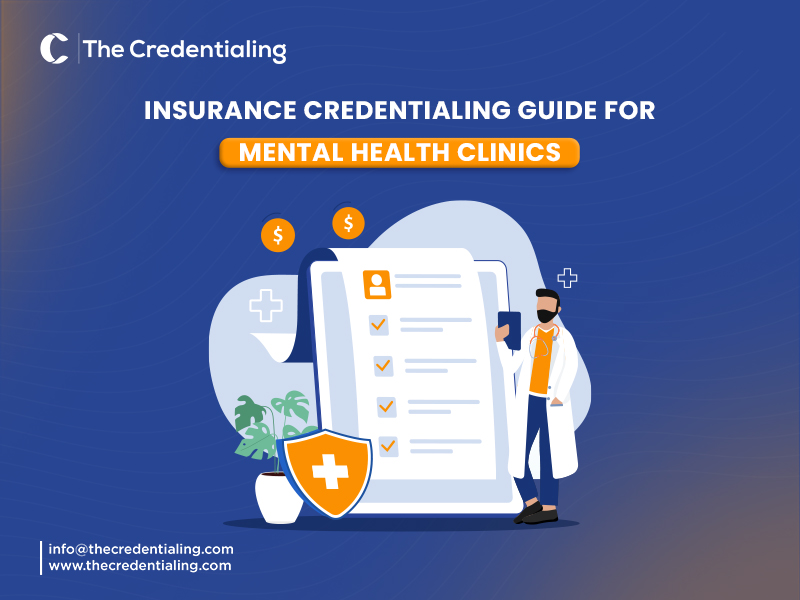Insurance Credentialing Guide for Mental Health Clinics
Mental health clinics must successfully navigate the complicated world of insurance credentialing to guarantee they can provide treatments to a broad spectrum of patients. For healthcare professionals to be paid for services provided to insured patients, they must confirm through the credentialing process that they fulfill the requirements established by insurance companies. This guide also offers helpful hints and insights to give mental health clinics a thorough understanding of the insurance credentialing procedure and make the process go more smoothly.
Understanding Insurance Credentialing
The process of confirming and assessing healthcare professionals' credentials, including their education, training, experience, and competency, is known as insurance credentialing. By going through this procedure, insurance companies can be sure that providers fulfill the requirements to be part of their network. Credentialing is crucial for mental health clinics to draw in a varied patient population, establish credibility, and guarantee financial stability through insurance payouts.
Why Credentialing Matters
Four solid reasons emphasize the importance of credentialing:
- Credentialed providers can treat patients covered by various insurance plans, expanding the clinic's patient base.
- Credentialing allows clinics to receive payment from insurance companies for services rendered.
- Being credentialed enhances the clinic's reputation and trustworthiness.
- Credentialing ensures regulatory and industry standards compliance, reducing legal and financial risks.
Steps in the Credentialing Process
1. Preparation and Documentation
The first step in the credentialing process is gathering the necessary documentation. This typically includes:
- Proof of education (degrees, transcripts)
- Licenses and certifications
- Professional liability insurance
- Curriculum vitae (CV)
- Work history and references
- National Provider Identifier (NPI)
- Background checks
2. Application Submission
Once the documentation is ready, the next step is to complete and submit applications to the relevant insurance companies. This involves:
- Identifying Payers: Determine which insurance companies you want to work with based on the patient demographics and coverage in your area.
- Access the credentialing applications from the insurance
- Completing Applications: Fill out the applications accurately, ensuring all required information and supporting documents are included.
3. Primary Source Verification
Insurance companies will verify the information provided in the application through a process called primary source verification. This includes:
- Confirming educational qualifications and training with institutions
- Verifying licenses and certifications with issuing bodies
- Checking work history and references
- Conducting background checks
4. Credentialing Committee Review
The application is examined by the insurance company's credentialing committee following primary source verification. This committee assesses the provider's overall network suitability, experience, and qualifications.
5. Contracting and Enrollment
The provider and the insurance company will sign a contract if the application is accepted. The terms and conditions of joining the network, such as payment schedules, invoicing guidelines, and compliance standards, are described in this contract. The provider is formally enrolled in the insurance network as soon as the contract is signed.
Tips for a Smooth Credentialing Process
1. Stay Organized
It's critical to maintain an orderly structure for tracking application status and maintaining documents. Use credentialing software or create a thorough checklist to ensure that all necessary documents are gathered and submitted on time.
2. Be Accurate and Complete
Ensure that all applications are filled out accurately and completely. Incomplete or incorrect applications can lead to delays or denials. Double-check all information and include all necessary supporting documents.
3. Follow Up Regularly
Credentialing can be a lengthy process, often taking several months. Regularly follow up with insurance companies to check the status of applications and address any issues promptly. Persistence is critical to avoiding unnecessary delays.
4. Keep Licenses and Certifications Current
Ensure that all licenses and certifications are up to date and renew them as required. Expired credentials can result in application denials or interruptions in network participation.
5. Utilize Credentialing Services
Consider using third-party credentialing services to manage the process. These services have expertise in navigating the complexities of credentialing, saving time, and reducing administrative burdens.
Common Challenges in Credentialing
1. Time-Consuming Process
Credentialing can be time-consuming, often taking several months to complete. This can be challenging for new clinics or providers eager to start serving patients and receiving reimbursements.
2. Variability Among Insurers
Each insurance company has its own credentialing requirements and processes, adding complexity and requiring careful attention to detail.
3. Maintaining Compliance
For this reason, it is crucial to maintain compliance with the credentialing rules and guidelines consistently. It is also critical that providers be up to date with the CE's, license renewals and all other professional requisites to ensure that there is no disruption in participation in the network.
4. Managing Rejections and Appeals
The reasons for rejection may include missing information and/or inconsistent information provided in the documents. One should comprehend the causes of rejection and take the right course of action to correct mistakes and initiatives.
Conclusion
Insurance credentialing is another crucial process that mental health clinics undertake to increase market access and stability as well as the clinic's standing. Although it is quite a lengthy process, the following are some tips that can help to ease credentialing: This paper aims to describe the steps taken through the credentialing process and the challenges likely to be encountered along the process so that mental health clinics can benefit from the information and in turn be in a position to offer the best services to their patients and at the same time improve their practice.
